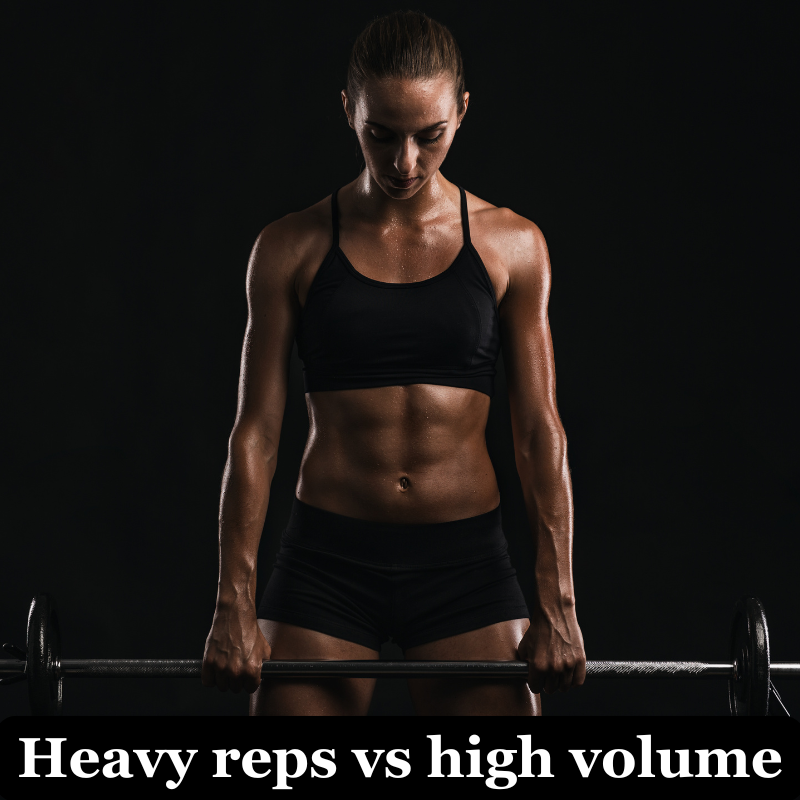Weight Loss Through Resistance Training

What is better for weight loss when we do strength/resistance exercise. Lower weight higher reps (LWHR) or heavier weight and low reps (HWLR). Strength/resistance training stands out as a top tier form of exercise, melting fat and boosting your metabolism for weight loss optimization. Figuring out the right number of reps and weight to lift for weight loss can be tough. If you're lifting 50% of your max strength for 4-5 reps, it's like dropping a grain of sand in a huge bucket of weight loss that'll never get filled.
A common question and a topic of discussion which recently came up between me and a friend leads into our topic of choice today. It started out with a discussion about opposing ideas around progressive overload as it relates to heavier weights to build muscle (LWHR) and lose weight instead of higher reps (HWLR).
“You could use the same weight but go for higher volume,” I said. She countered, no you need more weight for progressive overload, not more volume, so you build muscle and increase the resting metabolic weight to lose weight.
Muscle, metabolism, and mitochondria all tell the same story: real vitality. More muscle means better insulin sensitivity, stronger mitochondria, and defense against the slow decline into chronic disease. This is what thriving looks like, biologically.
It got me thinking that applying simple principles for weight loss should be easy. There seems to be an underlying gap of knowledge applying real life actions to complete the weight loss goals.
What does the evidence say
Progressive overload is the intentional, gradual increase in physical stress on the muscles, typically by adding weight, reps, sets, or training volume so we can stimulate muscle growth, strength, and metabolic adaptation. Without this progressive challenge, the body adapts to a fixed workload, leading to plateaus and stalled progress in both muscle gain and fat loss. Building muscle is like boiling water. If you don’t keep turning up the heat, the water stays warm but never boils. Progress stalls without intensity.
2020 study in Frontiers in Physiology emphasized that progressive overload, regardless of rep range, is essential for body composition improvements, as it drives muscle hypertrophy and strength, which elevates calorie burn. Mixing up rep ranges with overload beat static plans for fat loss.
The nitty gritty
Higher-rep training burns more calories per session because of longer workouts and greater total volume, as long as you take the volume close to failure.
A 2018 study compared high-rep (20–25 reps) vs. low-rep (8–12 reps) training in women over 8 weeks. While both groups lost similar amounts of body fat with controlled calorie intake, the high-rep group showed slightly greater improvements in muscular endurance.
For muscle preservation and strength gains, a heavy weight, low-volume approach is best.
For more muscle and a higher metabolism, focus on higher volume, lower weight training.
Big picture
Let's focus on how nutrition and resistance training help with weight loss. While weightlifting burns calories, builds muscle, and boosts metabolism, poor diet negates its weight loss benefits. You can't overcome a poor diet through hard work alone.
It all boils down to this: neither approach is clearly better for weight loss; they both work if you limit your calories and focus on protein.
Key points
- Weight loss needs a calorie deficit
- Total work (volume) matters most for body comp. Think less fat, more muscle.
- Newbies do great with LWHR; pros need HWLR to save muscle.
- The optimal choice involves combining elements from both workout plans. Alternate between high-rep, low-weight days and low-rep, high-weight days.
The Spark and the Shield
Progressive overload is your spark. It lights the fire for growth by accumulating weight, reps, or sets. Without it, your body adapts and stalls. No spark, no flame. But even fire needs fuel. By shielding joints, hormones, and mitochondria from exhaustion, recovery acts as a shield. Schedule a deload week every 4–6 weeks to avoid overtraining and build strength.
LWHR vs. HWLR? One’s the grindstone, one’s the anvil. Beginners can start with calorie-burning, endurance-building LWHR. Seasoned lifters use HWLR to build muscle and boost metabolism. Don’t want to choose, then cycle both. LWHR piles on volume; HWLR drives intensity. Together, they carve a stronger, leaner you. Pair with a 500–750 calorie deficit and adjust based on feel. Work and rest, heavy and light, spark and shield. Balance them, and you don’t just lose fat, you build a high-performance engine for life.